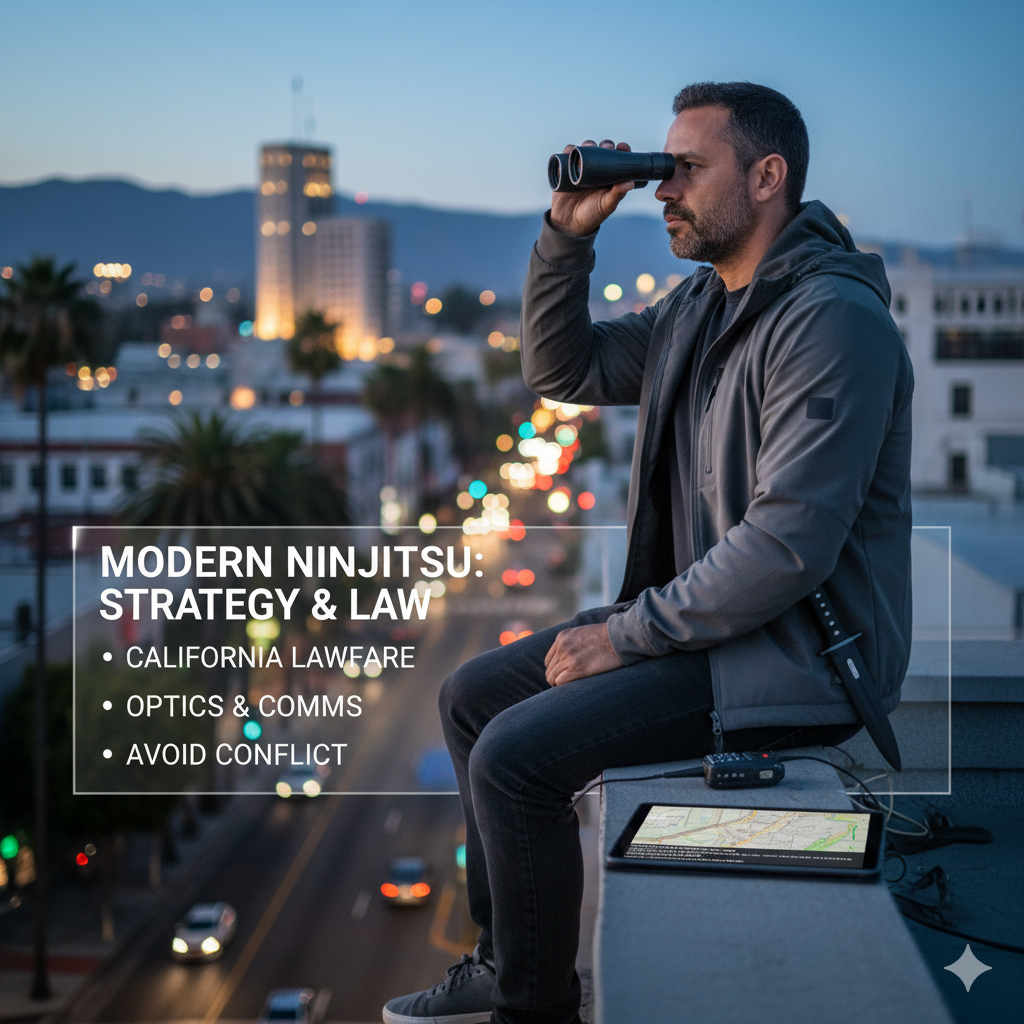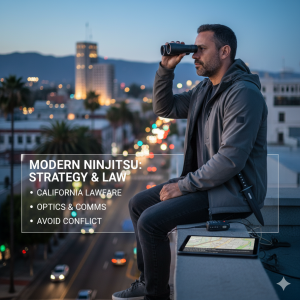Crucial Legal Disclaimer
I am an AI assistant and not an attorney. This information is for educational and illustrative purposes only and does not constitute legal advice. Before teaching any class involving weapons, self-defense, or “rules of engagement, you must consult with a qualified California or North Carolina attorney. Teaching these subjects incorrectly can expose you and your students to significant legal liability.
Class Outline: Modern Ninjitsu (Strategy & Law)
Module 1: Philosophy & Core Concepts
- What is “Modern Ninjitsu”?
- Define the term for your class. Frame it not as historical reenactment, but as the modern application of “ninja” principles: intelligence, stealth, evasion, efficiency, and preparedness.
- Core Principle: Emphasize that the primary goal is avoiding conflict through superior awareness and strategy. Physical engagement is an absolute last resort.
- The “Secrets”: Modern Applications
- Invisibility (The “Gray Man” Theory): Blending into modern urban environments. This isn’t about black pajamas; it’s about social camouflage, appearing unremarkable, and not drawing attention.
- Espionage (Information Gathering): Modern “spying” is open-source intelligence (OSINT). Teach students how to legally gather information from public records, social media, and observation to build situational awareness.
- Evasion & Escape (Route Planning): How to mentally and physically map escape routes in any environment (a building, a street, a crowd).
Module 2: Tools of the Trade (Non-Weapon)
This module covers the “optics, rangefinders, and radios” you mentioned. The focus is on information dominance.
- Optics (Binoculars/Monoculars):
- Techniques for discreet observation.
- Understanding vantage points.
- Counter-observation (detecting if you are being watched).
- Rangefinders:
- Using distance estimation for planning, navigation, and creating mental “safety zones.”
- Radios (Secure Comms):
- The difference between FRS, GMRS, and Ham radio (and their legal requirements).
- Basic radio discipline (brevity, clear communication).
- Principles of communication security (avoiding eavesdropping).
Module 3: The Weapon (Dagger) & California Law
This is your most legally sensitive module.
- The Dagger as a Tool:
- First, frame the dagger (or any knife) as a utility tool (cutting rope, opening packages, first aid).
- California Knife Law (The “Dagger Problem”):
- You must be extremely clear here. California law is highly restrictive regarding “dirks” and “daggers.”
- California Penal Code 21310: Generally prohibits carrying a “dirk or dagger” concealed on your person. A “dirk or dagger” is broadly defined as a knife capable of being used as a stabbing weapon.
- Open Carry: While not explicitly prohibited by PC 21310, open carry of fixed-blade knives is often restricted by local ordinances (city and county laws). Furthermore, openly carrying a dagger is tactically unwise and will draw immediate law enforcement attention.
- Legality vs. Reality: A key part of your class must be “Just because it’s technically legal to own, carrying it in public is a massive legal risk.”
- Recommendation: Strongly advise students against carrying a dagger for self-defense due to the legal minefield. A folding knife under a certain blade length (check local ordinances) might be a more defensible choice, but even that carries risks.
Module 4: Rules of Engagement (Civilian Self-Defense)
Frame “Rules of Engagement” as the legal and ethical standards for using force as a civilian.
- When is Force Justified?
- Reasonable Belief: The core of self-defense. A “reasonable person” in the same situation would believe they were in imminent danger of unlawful bodily harm.
- Imminence: The threat must be happening right now. You cannot use force for a threat that happened yesterday or might happen tomorrow.
- Proportionality of Force:
- Lethal vs. Non-Lethal: This is critical. You can only respond with force that is proportional to the threat.
- Using a dagger is deadly force. You can only use deadly force if you reasonably believe you are in imminent danger of death or great bodily injury (GBI).
- You cannot use a dagger (deadly force) to stop someone from punching you (non-deadly force), unless you can prove you reasonably feared that punch would lead to your death or GBI.
- California “Stand Your Ground” / Castle Doctrine:
- California has no “duty to retreat” in public. If you are in a place you have a legal right to be, you are not required to run away before defending yourself.
- Castle Doctrine: This applies to your home. You have a legal presumption that you are in reasonable fear of death/GBI if someone forcibly and unlawfully enters your home.
Module 5: “Lawfare Defense” (The Aftermath)
Frame this as “Legal Defense Strategy” or “What to Do After a Self-Defense Incident.”
- The “Ninja’s” Worst Enemy: The Legal System
- Emphasize that the real fight begins after the physical one.
- Step 1: Call 911
- Be the first to call. State your location, that you were attacked, you defended yourself, and you need police and an ambulance.
- Step 2: The “Magic Words”
- When police arrive, you must say two things:
- “I was attacked, I was in fear for my life, and I had to defend myself.”
- “I wish to remain silent, and I want my lawyer.”
- When police arrive, you must say two things:
- Step 3: Say Nothing Else
- Do not explain what happened. Do not “tell your side of the story.” Any statement you make can and will be used against you. Adrenaline makes people say things that are factually wrong, which prosecutors will use to destroy your credibility.
- The “Vigilante” Problem
- Warn students that any “ninja” gear, talk of “ninjitsu,” or evidence of “strategy” training (like your class) can be used by a prosecutor to paint them as a “vigilante” who was looking for a fight, not a victim who defended themselves.
- This is the ultimate “lawfare” attack: using your own preparation against you to negate your self-defense claim. The defense is silence and a good lawyer.




Reviews
There are no reviews yet.